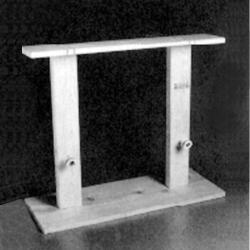Source Institutions
Source Institutions
Add to list Go to activity
Activity link broken? See if it's at the internet archive

In this activity and demonstration about electricity and magnetism, learners observe how the current generated when one copper coil swings through a magnetic field starts a second coil swinging. Learners also explore what happens when they change the polarity of the magnet, reverse the coil, or add a clip lead to short-circuit the coils. Use this activity to illustrate how electricity and magnetism interact. The assembly of the electromagnetic swing device takes about an hour.
- 45 to 60 minutes
- 10 to 30 minutes
- $10 - $20 per group of students
- Ages 8 - 18
- Activity, Demonstration
- English
Quick Guide
Materials List (per group of students)
- One 1 x 12 in (2.5 x 30 cm) board, 24 inches (60 cm) long
- Two 2 x 4 in (5 x 10 cm) boards, 18 inches (45 cm) long
- One 1 x 4 in (2.5 x 10 cm) board, 24 inches (60 cm) long
- One 9/16 in (14 mm) drill bit (for cow magnet holes) and drill
- Carpenter's tools: Ruler, pencil, hammer or screwdriver, saw.
- Nails or screws
- Magnet wire (#22 gauge or finer) for the coils (Available at Radio Shack on prewound, individual plastic spools.)
- Masking tape
- 2 cow magnets (usually 1/2 inch [1.3 cm] diameter, available at feed stores). Make sure you get the cylindrical ones with the north and south pole at the ends, not the rectangular ones with north and south poles on the faces.
- An electrical lead wire with alligator clips at both ends (available at Radio Shack)
- Adult help
Subjects
-
Physical Sciences
-
Electricity and Magnetism
- Electric Charges and Currents
- Electromagnetic Fields
- Electric Circuits
-
Electricity and Magnetism
-
The Nature of Science
-
The Scientific Process
- Conducting Investigations
-
The Scientific Process
Audience
To use this activity, learners need to:
- see
- touch
Learning styles supported:
- Involves hands-on or lab activities
Other
This resource is part of:
Access Rights:
- Free access
By:
Rights:
- All rights reserved, The Exploratorium,
Funding Sources:
- National Science Foundation
- California Department of Education
- NEC Foundation of America
